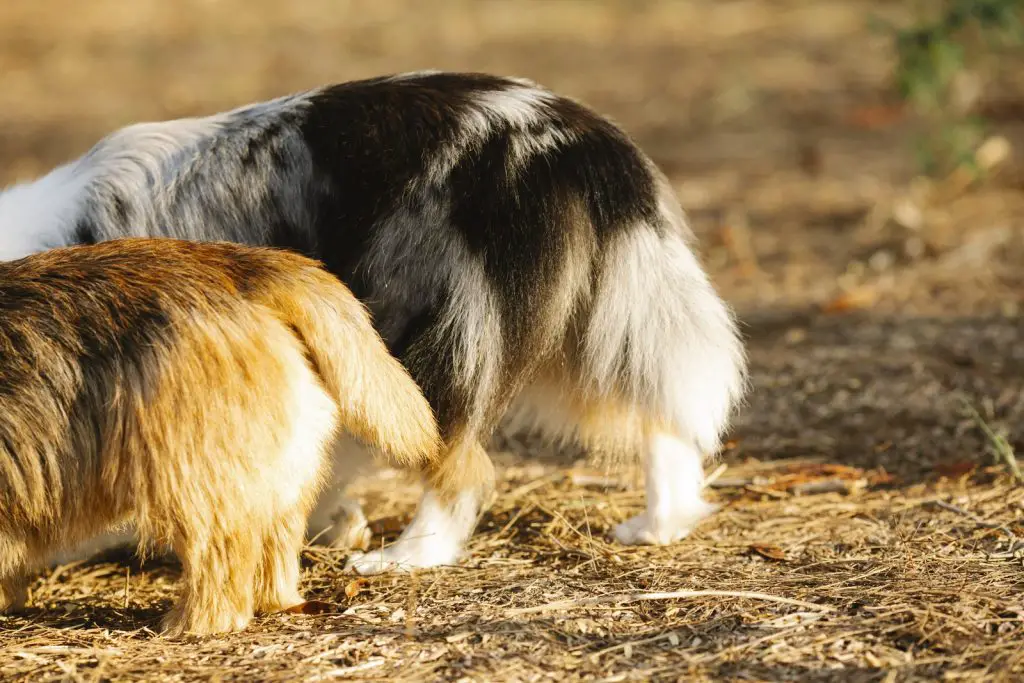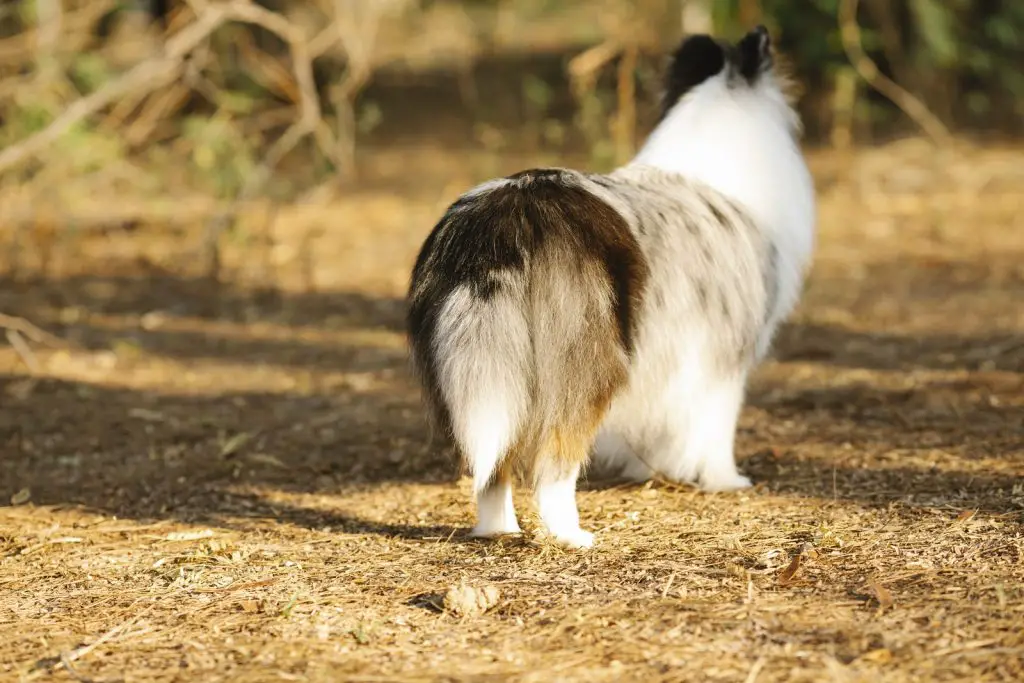Every dog owner has wondered why do dogs tuck their tails.
There is so much that the tail of a dog can reveal about a dog’s behavior. Just like other tail movements, many dog owners often wonder why do dogs tuck their tails. It is almost as if it is trying to establish itself as small as possible.
Dogs tuck their tails for any reason, from being nervous to being scared. At times, an underlying medical condition can also be a reason why your dog is tucking its tail. However, learning this language is not as difficult as it seems.
With a few accompanying signs, you can interpret the reason why your dog is tucking its tail at a particular moment. Find out all the reasons here why your dog is doing so and how you should respond to such behavior!

Emotional Reasons Why Your Canine May be Tucking Its Tail
Dogs use their body language to communicate and express their moods and feelings. Merely observing the tail of your dog can tell you so much about what it’s currently feeling.
A tucked tail, for one, indicates fear, uncertainty, and frustration in dogs. Following are some common types of moods that make your dog tuck its tail underneath and provide answers to why do dogs tuck their tails.
More often than not, when your dog tucks its tail below its hind legs, then it is likely afraid of something. Sometimes, dogs feel scared in the presence of another animal. Your dog’s fear can be different from that of feeling dominated by another animal.
It could be because of the fact you took out its carrier from the closet, and now the dog is frightened that you might take it for grooming. This behavior could also mean that your dog is trying to plead you to leave him alone.
It is worth mentioning that you should not, for a second, assume that a scared dog won’t turn aggressive. If its fear increases and it becomes defensive, it might expose its teeth to threaten to bite others. I cannot emphasize enough that you must always be extremely cautious in the presence of a frightened dog.
Your dog might also tuck their tail to signify submissiveness or let you know that they feel vulnerable. Usually, dogs who feel like subordinates often tuck their tail to show that they surrender in front of some other animal’s dominance. A dog on a vet’s table might also feel threatened and so give in to the whole situation by tucking its tail under his hind legs.
A tucked tail also signifies that your dog is worried about something. He might be feeling uneasy and uncertain about a thing, and feel anxious. For other signs, observe his ears, which might be a bit pushed back too. This can give you a clear idea that something is not right, and your dog feels unsettled.
Changes in lifestyles, unfamiliarity with an environment, or the presence of many people he doesn’t know in your house can make your dog tuck its tail underneath its body. Dogs feel comfortable with stability and usual routines; something out of the ordinary can make them feel frustrated and cause anxiety.
Tucking of the tail might not necessarily mean that your dog feels threatened or unsettled. A puppy or a young dog may sometimes go in tuck its tail to display admiration and esteem to other dogs.
If you notice that your dog tucks its tail and then moves away from something, it indicates stress. It means that your dog is feeling like a wreck and helpless about his situation. If your dog watches you leaving or packing, it might tuck its tail and move away to avoid the situation. He is most likely doing this because he does not want you to go.
Similarly, the addition of a new pet to your household can also stress your dog. It might feel jealous and left out. Stress like fear can also make your dog aggressive, so it is best to be patient and cautious. You can coax your dog out of stress by giving it some extra attention and love.
Here is a good video on why do dogs tuck their tails.
Health Conditions that Make Dogs Tuck their Tails
A number of underlying health conditions could be the reason behind why do dogs tuck their tails. The different movements and positions of a dog’s tail tell you a lot about how your dog is feeling and what it wants. It can be frustrating for a dog owner to figure out why exactly their dog is exhibiting such behavior.
If it happens once, it is probably nothing to worry about. But, if your dog continues to tuck its tail often, it should indicate to you that there might be other reasons why your dog is doing so.
Apart from emotional reasons, dogs also tuck their tail as a response to some health conditions. Some of these conditions are easy to identify due to visible injuries, while you might not be able to identify others unless you take your dog to a vet. You can use some help from this guide to detect or rule out a possible medical condition.
Following are some canine disorders that can cause your dog to tuck its tail.
If a dog always keeps tucking its tail between his legs, your dog might be in pain. Dogs’ tails get fractured very quickly, and the breeds with longer tails are more at risk of hurting their tail. A fractured or dislocated tail can be very painful for your dog.
There can be many reasons that can cause a tail fracture in dogs. Falling from a height, something heavy dropping on the dogs’ tail, getting struck by a vehicle, or the tail getting crushed by something can be some of the causes of tail fracture in dogs.

Symptoms of a Tail Fracture
Some common signs that indicate that your dog might have fractured its tail are as follows:
- Bleeding
- Difficulty in walking
- Chewing and licking tail repeatedly
- Loss of hair in the tail region
- Dog not wagging its tail as usual
- Crying or whimpering
How You Should Respond to a Dog’s Fractured Tail?
Recovery depends on several factors, including the cause and severity of the injury and whether the effects of the fracture will be permanent or temporary, etc. The owner should ensure that the dog rests as much as possible and does not move actively.
Dog owners must also provide a nutritious diet and a clean environment to help their dogs recover faster. In most cases, your dog should be able to recover from a tail fracture within a few weeks to months.
Another health condition that can make your dog tuck its tail between its legs is limber tail syndrome. It is a disorder within the muscles of the tail and can occur from the excessive use of the tail. A lot of strain on the tail can cause harm to the vertebrae bones, muscles, and surrounding ligaments. Being in cold water or inclement weather poses a risk to your dog’s condition.
Symptoms
A dog tucking its tail between its legs is the most common symptom of limber tail syndrome. It shows that the dog is dealing with some pain, and, with this, it also tries to express that something is wrong with it. There are some other symptoms related to this condition that begin appearing within a day after the dog starts experiencing this condition. These symptoms are as follows:
- Tail upright for 2-3 inches and then hanging downwards limply towards hind legs
- Difficulty in sitting down or the dog refuses to sit
- Tucks tail between legs constantly
- Difficulty in pooping
- Swelling at the bottom of the tail
- Changes in appetite
- Whimpering
How You Should Respond to Limber Tail Syndrome in Dogs?
The standard treatment of limber tail syndrome is giving your dog anti-inflammatory medication and making it rest. The swelling and pain can get worse with active movements, so ensure that your dog avoids excessive movement. This condition would most probably last for a week, and after that, the dog will return to his usual activities.
It is improbable that a dog who has suffered from limber tail syndrome will develop the condition again. Once the tail has healed completely, you can allow your dog to go about his business as he likes.
Dogs wag their tails excitedly when they are so glad, but this can cause a problem. Some dogs are bulky and powerful and can hurt their tails due to excessive wagging. This condition is known as happy tail syndrome.
Some big dogs are more likely at risk of this condition. It causes injury usually at the top of the tail as the skin is not very thick in that area. It is a bit difficult to treat this condition due to the region of the injury and your dog’s urge to wag its tail.
Symptoms
The most apparent signs of happy tail syndrome are the injured tip of the tail and your dog tucking it between its legs. Most tail injuries cause visible wounds that you should be able to notice quite quickly.
However, you should also keep an eye on the dramatically changing or limiting movements of your dog’s tail. These movements tell you a lot about your dog’s physical and emotional condition.

How You Should Respond to Happy Tail Syndrome in Dogs?
If your dog does not rest and allow its tail to heal, happy tail syndrome can turn from a minor problem into a severe condition. During this condition, if your dog tucks its tail between its legs, it is, in fact, a good thing. However, you have to look out for any signs of infection in the region of the injury. Keep the tail clean and covered to prevent an infection.
Before bandaging, clean the wounded area properly. Apply a topical antibiotic medicine that your veterinarian prescribes, and also spread it around the wound to prevent infection. Now, wrap a bandage on the injury and make sure to change it every day until the wound heals.
A tucked tail between legs could also mean a skin infection on the dog’s tail. Skin infections on a tail can occur due to many reasons, but mostly happen because the dog scraped its tail or injured it. This can make the tail catch a skin infection.
The most common skin infection in dogs is pyoderma, which is caused by bacteria, fungus, or parasites. You do not have to fret over it much as it is the most common reason most dog owners take their dogs to the vet.
Symptoms
The most widely occurring symptom of pyoderma is the appearance of papules or pustules. They look much like human pimples, red on the outsides, and filled with pus in the center. Other symptoms include:
- Itchiness
- Dry patches of skin
- Loss of hair in the infected region
- Circular crust
- Tail tucking
How You Should Respond to Pyoderma in Dogs?
The standard treatment for pyoderma means the vet will prescribe your dog antibiotics for two to six weeks. Most of the time, you can resolve this problem with the use of prescribed antibiotics in combination with topical skin medicine. Make sure you give your dog baths regularly and keep it as clean as possible.
Fleas are small brown parasites that go to dogs as they go to humans for blood. They want warm temperatures, which is why you are most likely to notice fleas only in the summer.
A dog tucking its tail between its legs is a way of telling the owner that the fleas are bothering them. These parasites also have strong hind legs, which help them jump from one animal to another.
Symptoms
The visible reaction to the presence of fleas in most dogs is an exhibit of discomfort and irritation. Some dogs might not display any signs of frustration at all. Following are some common symptoms of flea infestation in canines:
- Excessive rubbing, chewing and licking of the skin
- Redness and scabbing
- Loss of hair
- Presence of fleas on the body
- Skin sores
- Tail Tucking
- Changes in behavior
How You Should Respond to Fleas in Dogs?
The first thing you should do after noticing the symptoms of a flea infestation is to take your dog to a veterinarian. You should never ignore it or take it lightly because it can make the problem even worse. Your dog’s treatment is more important than removing fleas from your home.
Your vet will likely prescribe a flea shampoo, which is the most effective way to get rid of fleas. Bathe your dog regularly with the shampoo and keep it as clean as possible. The vet might also prescribe insect growth regulators (IGR) as well as anti-flea medications.
Follow the instructions of the vet meticulously to help your dog get rid of the problem. Also, take preventive measures to avoid flea infestation in the future.
Here is another video on why dogs put their tail between their legs and reasons behind this behavior.
Conclusion
Dogs have been man’s best friend since time immemorial. Early humans first had grey wolves as pets. The wolves evolved and learned to read human expressions, while humans tamed them and learned to understand their needs. These grey wolves gradually evolved into the dogs that we know and love today.
We raised puppies well before we had cats, sheep, or chicken. Dogs have been a familiar part of our lives way before we herded cattle or learned to grow crops.
While we already know a lot about canine body language and needs, when I look at my dog, it feels there is yet so much to learn. Like when I get back home from work, my dog wags its tail, loosely shakes his entire body, and gives a grin. It feels welcoming and delightful.
It can be challenging to understand why do dogs tuck their tails, but I recommend you to look for accompanying signs that can give you an idea. If you feel it is because of emotional reasons, first check for any signs of aggression.
Do not approach the dog if it is feeling threatened as it can aggravate its anxiety. Sit down on the dog’s level and offer a treat to show you are friendly. Also, avoid staring because constant eye contact means a threat in dog language. Coax your dog with soothing words and behavior.
If the accompanying signs with the tucking of tail indicate any health condition, it is best to take your dog to a vet for professional advice and treatment. Regardless of the reason why your dog is tucking its tail, try to make your dog feel comfortable and loved when it exhibits such behavior.







